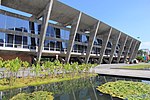Estaleiro Mauá

Mauá Shipyard SA is the oldest private Brazilian shipyard, being surpassed only by the state-owned Arsenal da Marinha do Brasil, which was founded in 1808. Its origin is the Anglo-Brazilian company Estabelecimento de Fundição e Estaleiros da Ponta d'Areia, located in Niterói, Rio de Janeiro, and was bought on August 11, 1846, by Irineu Evangelista de Sousa, at the time Baron of Mauá.In 2000, the company entered into a joint-venture with Jurong Shipyard in Singapore, creating the company Mauá Jurong S/A (MJ). The new company, in addition to the construction and repair of ships, specializes in the construction of platforms for oil and gas exploration.
Excerpt from the Wikipedia article Estaleiro Mauá (License: CC BY-SA 3.0, Authors, Images).Estaleiro Mauá
Estaleiro Mauá, Niterói Ponta d'Areia (Região Praias da Baía)
Geographical coordinates (GPS) Address Nearby Places Show on map
Geographical coordinates (GPS)
| Latitude | Longitude |
|---|---|
| N -22.8772 ° | E -43.1283 ° |
Address
Estaleiro Mauá (Rua Barao de Maua)
Estaleiro Mauá
24030-020 Niterói, Ponta d'Areia (Região Praias da Baía)
Rio de Janeiro, Brazil
Open on Google Maps








